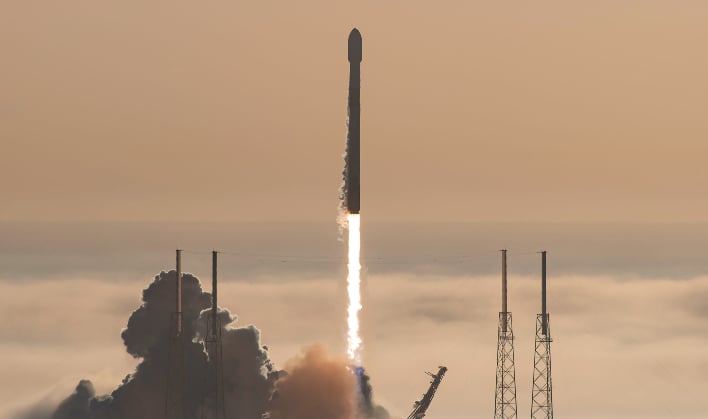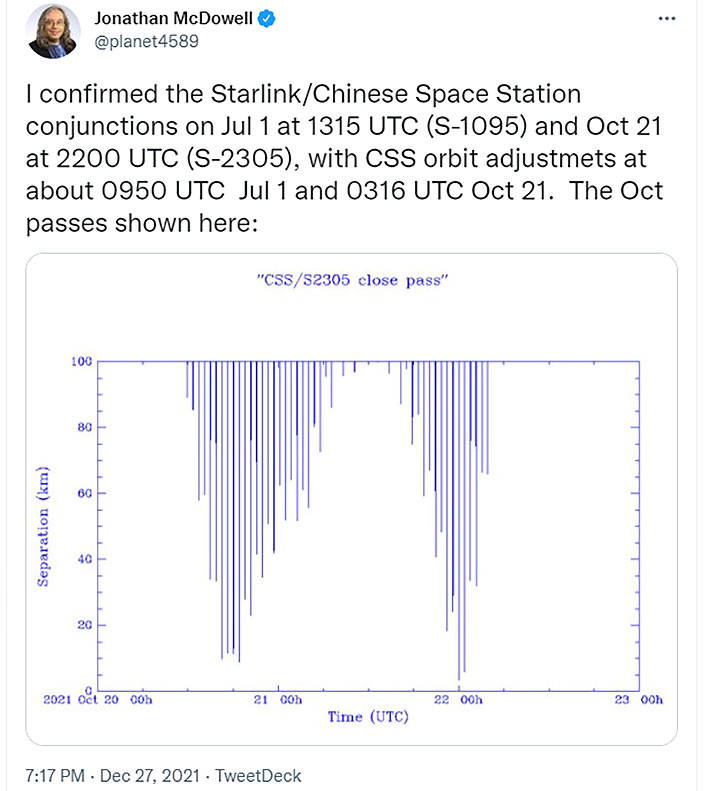China Is Fed Up After Its Space Station Has To Dodge SpaceX Starlink Satellites Again

Just over a month ago a Russian Anti-Satellite test (ASAT) destroyed one of its own out of service satellites, leaving behind a debris field that had NASA and others fuming. Apple co-founder Steve Wozniak announced shortly after that he was launching a company, Privateer, in order to look at studying and classifying space debris in an attempt to head off the Kessler Syndrome. But it isn't "space debris" that prompted China to file a complaint with the United Nations recently. No, it was actually two separate incidents with Starlink satellites where China's Space Station was presumably put into possible danger.
In a formal complaint to the United Nations, China cited two separate occasions where a Starlink satellite prompted an evasive maneuver to be made to the Chinese Space Station in order to avert a possible collision. The complaint points to Article V of the Treaty on Principles Governing the Activities of States in the Exploration and Use of Outer Space and Other Celestial Bodies (the Outer Space Treaty). Article V states that nations part of the treaty are to immediately inform the United Nations of any "phenomena" that is discovered in space that could pose a danger to the life or health of astronauts.
The first incident that China reported in the complaint identified Starlink-1095 satellite as maneuvering continuously to an orbit that caused a close encounter with the Chinese Space Station on July 1, 2021. The second incident identified Starlink-2305 satellite doing the same type of maneuvering and once again evasive maneuvers were taken by the space station on October 21, 2021. In both instances, China states that it was forced to make evasive maneuvers in order to ensure the safety of both the space station and the crew aboard.
Elon Musk's broadband satellite company, Starlink, has been constantly launching more satellites into orbit in order to try and keep up with demand for the service. As more people are added to the satellite based internet service, the need for more satellites is essential to being able to provide the bandwidth for the speeds that have made it so popular. In a recent report by Ookla, it was pointed out that speeds of Starlink's internet had seemed to slow in certain areas as more people were being added. So, it is no surprise that Musk has been eager to launch additional satellites into orbit to try and keep up. As of right now, SpaceX has launched 1,900 Starlink satellites into space and has a license to deploy a constellation made up of over 12,000 satellites.
A Starlink satellite was the cause of another incident in 2019 when one of them prompted a European spacecraft to make evasive maneuvers in order to avoid a collision. In that incident, SpaceX stated "a bug in our on-call paging system" caused a communications breakdown and led to the near miss.
However, China is not blameless when it comes to causing spacecraft to make evasive maneuvers. In 2007, a Chinese ASAT destroyed one of its own satellites and created a large orbital debris field. The debris field that was left behind has caused the International Space Station to perform evasive maneuvers throughout the years since. It is also interesting to note that China has not condemned Russia for its ASAT that caused a similar debris field in space recently either.
Regardless of China's true intent for filing the formal complaint with the United Nations (PDF), the fact that low orbit space is getting crowded is still a growing concern for all. With new satellites being launched on a regular basis and new ventures such as Blue Origin's business park in space, the issue of how the international community will deal with all the traffic will only continue to worsen. Hopefully studies, such as the one Steve Wozniak's company Privateer is slated to do, will lend some answers as to how we can avoid even more near misses. Because if not, all the near misses are likely to turn into unavoidable disasters in the future.
China seems to be tired of its Chinese Space Station having to make evasive maneuvers in order to avert collisions with Starlink satellites. The nation has taken action by filing a formal complaint with the United Nations over two recent incidents.
Just over a month ago a Russian Anti-Satellite test (ASAT) destroyed one of its own out of service satellites, leaving behind a debris field that had NASA and others fuming. Steve Wozniak, Apple co-founder, announced shortly after that he was launching a company, Privateer, in order to look at studying and classifying space debris in an attempt to head off the Kessler Syndrome. But it isn't "space debris" that prompted China to file a complaint with the United Nations recently. No, it was actually two separate incidents with Starlink satellites where China's Space Station was presumably put into possible danger.
In a formal complaint to the United Nations, China cited two separate occassions where a Starlink satellite prompted an evasive maneuver to be made to the Chinese Space Station in order to avert a possible collision. The complaint points to Article V of the Treaty on Principles Governing the Activities of States in the Exploration and Use of Outer Space and Other Celestial Bodies (the Outer Space Treaty). Article V states that nations part of the treaty are to immediately inform the United Nations of any "phenomena" that is discovered in space that could pose a danger to the life or health of astronauts.
The first incident that China reports in the complaint identified Starlink-1095 satellite as maneuvering continuously to an orbit that caused a close encounter with the Chinese Space Station on July 1, 2021. The second incident identified Starlink-2305 satellite doing the same type of maneuvering and once again evasive maneuvers were taken by the space station on October 21, 2021. In both instances, China states that it was forced to make evasive maneuvers in order to ensure the safety of both the space station and the crew aboard.
Jonathon McDowell, an astronomer and leading orbit watcher, posted on Twitter that he had confirmed the two incidents between the Starlink satellite and the Chinese Space Station. In the post he also includes data from the October pass.
Elon Musk's broadband satellite company, Starlink, has been constantly launching more satellites into orbit in order to try and keep up with demand for the service. As more people are added to the satellite based internet service, the need for more satellites is essential to being able to provide the bandwidth for the speeds that have made it so popular. In a recent report by Ookla, it was pointed out that speeds of Starlink's internet had seemed to slow in certain areas as more people were being added. So, it is no surprise that Musk has been eager to launch more and more satellites into orbit to try and keep up. As of right now, SpaceX has launched 1,900 Starlink satellites into space and has a license to deploy a constellation made up of over 12,000 satellites.
A Starlink satellite was the cause of another incident in 2019 when one of the satellites prompted a European spacecraft to make evasive maneuvers in order to avoid a collision. In that incident, SpaceX stated "a bug in our on-call paging system" caused a communications breakdown and led to the near miss.
However, China is not blameless when it comes to causing spacecraft to make evasive maneuvers. In 2007, a Chinese ASAT destroyed one of its own satellites and created a large orbital debris field. The debris field that was left behind has caused the International Space Station to perform evasive maneuvers throughout the years since. It is also interesting to note that China has not condemned Russia for its ASAT that caused a similar debris field in space recently either.
Regardless of China's true intent for filing the formal complaint with the United Nations, the fact that low orbit space is getting crowded is still a growing concern for all. With new satellites being launched on a regular basis and new ventures such as Blue Origin's business park in space, the issue of how the international community will deal with all the traffic will only continue to worsen. Hopefully studies, such as the one Steve Wozniak's company Privateer is slated to do, will lend some answers as to how we can avoid even more near misses. Because if not, all the near misses are likely to turn into unavoidable disasters in the future.


